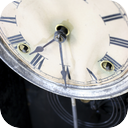(short preview of full seamless looping track)
(short preview of full seamless looping track)
(short preview of full seamless looping track)
(short preview of full seamless looping track)
(short preview of full seamless looping track)
Loud Grandfather Clock
This product is not available in the selected currency.
In Stock
Backordered
Out of Stock
Description
The silent house seems eerily haunted by the everlasting and profoundly persistent presence of time ticking away like some overly concerned parent protecting everyone in the home. Some may enjoy this absolute reminder, feeling its consistent sound to be comforting and predictable. While others may not appreciate the incessant noise that keeps cracking away at their attention when awake, and annoying their tranquility when trying to sleep. The grandfather clock, is a tall, freestanding, weight-driven pendulum clock with the pendulum held inside the tower, or waist of the case. Clocks of this style are commonly 1.8–2.4 metres (6–8 feet) tall. The case often features elaborately carved ornamentation on the hood, or bonnet, which surrounds and frames the dial, or clock face. The English clockmaker William Clement is credited with the development of this form in 1670. Most longcase clocks are striking clocks, which means they sound the time on each hour or fraction of an hour. The Oxford English Dictionary states that the 1876 song, My Grandfather's Clock, is responsible for the common name "grandfather clock" being applied to the longcase clock. However, the term appears as early as 1817 in Ovid's Art of love, Remedy of love, Art of beauty, and Amours, by John Dryden Ovid. In the early 20th century,quarter-hour chime sequences were added to longcase clocks. At the top of each hour, the full chime sequence sounds, immediately followed by the hour strike. At 15 minutes after each hour, 1/4 of the chime sequence plays, at the bottom of each hour, half of the chime sequence plays, and at 15 minutes before each hour, 3/4 of the chime sequence plays.
This sound uses the following file from Freesound: http://www.freesound.org/samplesViewSingle.php?id=127108
Opps
Sorry, it looks like some products are not available in selected quantity.



